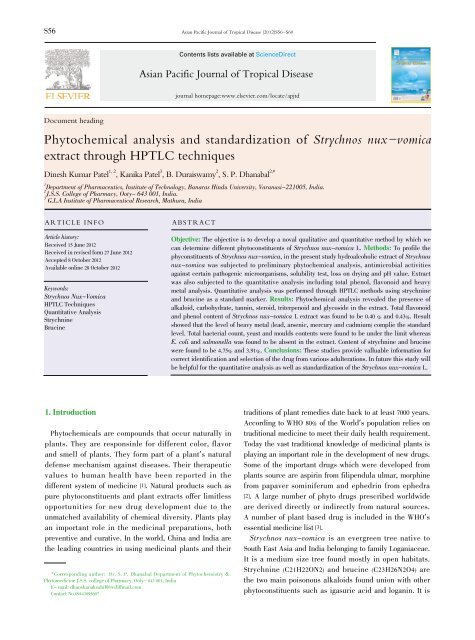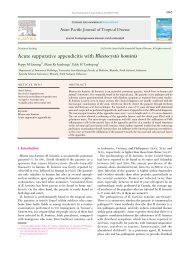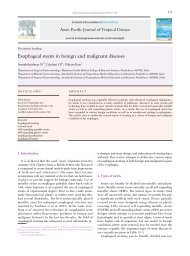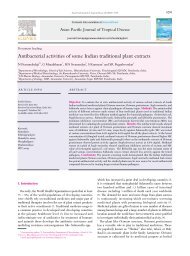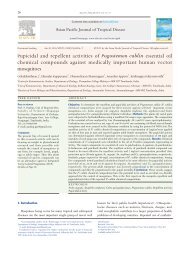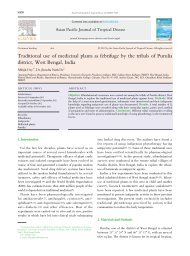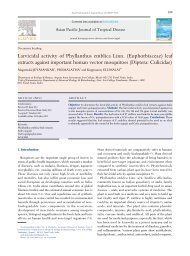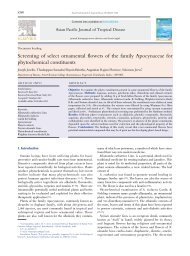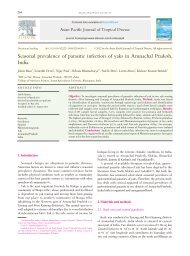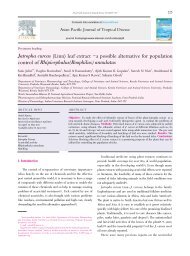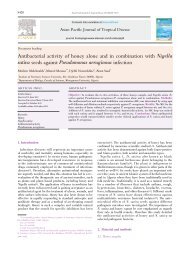Phytochemical analysis and standardization of Strychnos nux ...
Phytochemical analysis and standardization of Strychnos nux ...
Phytochemical analysis and standardization of Strychnos nux ...
Create successful ePaper yourself
Turn your PDF publications into a flip-book with our unique Google optimized e-Paper software.
S56<br />
Document heading<br />
Asian Pacific Journal <strong>of</strong> Tropical Disease (2012)S56-S60<br />
Asian Pacific Journal <strong>of</strong> Tropical Disease<br />
journal homepage:www.elsevier.com/locate/apjtd<br />
<strong>Phytochemical</strong> <strong>analysis</strong> <strong>and</strong> st<strong>and</strong>ardization <strong>of</strong> <strong>Strychnos</strong> <strong>nux</strong>-vomica<br />
extract through HPTLC techniques<br />
Dinesh Kumar Patel 1, 2 , Kanika Patel 3 , B. Duraiswamy 2 , S. P. Dhanabal 2,*<br />
1 Department <strong>of</strong> Pharmaceutics, Institute <strong>of</strong> Technology, Banaras Hindu University, Varanasi-221005, India.<br />
2 J.S.S. College <strong>of</strong> Pharmacy, Ooty- 643 001, India.<br />
3 G.L.A Institute <strong>of</strong> Pharmaceutical Research, Mathura, India<br />
ARTICLE INFO ABSTRACT<br />
Article history:<br />
Received 15 June 2012<br />
Received in revised form 27 June 2012<br />
Accepted 8 October 2012<br />
Available online 28 October 2012<br />
Keywords:<br />
<strong>Strychnos</strong> Nux-Vomica<br />
HPTLC Techniques<br />
Quantitative Analysis<br />
Strychnine<br />
Brucine<br />
1. Introduction<br />
<strong>Phytochemical</strong>s are compounds that occur naturally in<br />
plants. They are responsinle for different color, flavor<br />
<strong>and</strong> smell <strong>of</strong> plants. They form part <strong>of</strong> a plant’s natural<br />
defense mechanism against diseases. Their therapeutic<br />
values to human health have been reported in the<br />
different system <strong>of</strong> medicine [1]. Natural products such as<br />
pure phytoconstituents <strong>and</strong> plant extracts <strong>of</strong>fer limitless<br />
opportunities for new drug development due to the<br />
unmatched availability <strong>of</strong> chemical diversity. Plants play<br />
an important role in the medicinal preparations, both<br />
preventive <strong>and</strong> curative. In the world, China <strong>and</strong> India are<br />
the leading countries in using medicinal plants <strong>and</strong> their<br />
*Corresponding author: Dr. S. P. Dhanabal Department <strong>of</strong> Phytochemistry &.<br />
Phytomedicine J.S.S. college <strong>of</strong> Pharmacy, Ooty- 643 001, India<br />
E- mail: dhanskanaksahil@rediffmail.com<br />
Contact No.09443095697<br />
Contents lists available at ScienceDirect<br />
Objective: The objective is to develop a noval qualitative <strong>and</strong> quantitative method by which we<br />
can determine different phytoconstituents <strong>of</strong> <strong>Strychnos</strong> <strong>nux</strong>-vomica L. Methods: To pr<strong>of</strong>ile the<br />
phyconstituents <strong>of</strong> <strong>Strychnos</strong> <strong>nux</strong>-vomica, in the present study hydroalcoholic extract <strong>of</strong> <strong>Strychnos</strong><br />
<strong>nux</strong>-vomica was subjected to preliminary phytochemical <strong>analysis</strong>, antimicrobial activities<br />
against certain pathogenic microorganisms, solubility test, loss on drying <strong>and</strong> pH value. Extract<br />
was also subjected to the quantitative <strong>analysis</strong> including total phenol, flavonoid <strong>and</strong> heavy<br />
metal <strong>analysis</strong>. Quantitative <strong>analysis</strong> was performed through HPTLC methods using strychnine<br />
<strong>and</strong> brucine as a st<strong>and</strong>ard marker. Results: <strong>Phytochemical</strong> <strong>analysis</strong> revealed the presence <strong>of</strong><br />
alkaloid, carbohydrate, tannin, steroid, triterpenoid <strong>and</strong> glycoside in the extract. Total flavonoid<br />
<strong>and</strong> phenol content <strong>of</strong> <strong>Strychnos</strong> <strong>nux</strong>-vomica L extract was found to be 0.40 % <strong>and</strong> 0.43%. Result<br />
showed that the level <strong>of</strong> heavy metal (lead, arsenic, mercury <strong>and</strong> cadmium) complie the st<strong>and</strong>ard<br />
level. Total bacterial count, yeast <strong>and</strong> moulds contents were found to be under the limit whereas<br />
E. coli <strong>and</strong> salmonella was found to be absent in the extract. Content <strong>of</strong> strychnine <strong>and</strong> brucine<br />
were found to be 4.75% <strong>and</strong> 3.91%. Conclusions: These studies provide valluable information for<br />
correct identification <strong>and</strong> selection <strong>of</strong> the drug from various adulterations. In future this study will<br />
be helpful for the quantitative <strong>analysis</strong> as well as st<strong>and</strong>ardization <strong>of</strong> the <strong>Strychnos</strong> <strong>nux</strong>-vomica L.<br />
traditions <strong>of</strong> plant remedies date back to at least 7000 years.<br />
According to WHO 80% <strong>of</strong> the World’s population relies on<br />
traditional medicine to meet their daily health requirement.<br />
Today the vast traditional knowledge <strong>of</strong> medicinal plants is<br />
playing an important role in the development <strong>of</strong> new drugs.<br />
Some <strong>of</strong> the important drugs which were developed from<br />
plants source are aspirin from filipendula ulmar, morphine<br />
from papaver sominiferum <strong>and</strong> ephedrin from ephedra<br />
[2]. A large number <strong>of</strong> phyto drugs prescribed worldwide<br />
are derived directly or indirectly from natural sources.<br />
A number <strong>of</strong> plant based drug is included in the WHO’s<br />
essential medicine list [3].<br />
<strong>Strychnos</strong> <strong>nux</strong>-vomica is an evergreen tree native to<br />
South East Asia <strong>and</strong> India belonging to family Loganiaceae.<br />
It is a medium size tree found mostly in open habitats.<br />
Strychnine (C21H22ON2) <strong>and</strong> brucine (C23H26N2O4) are<br />
the two main poisonous alkaloids found union with other<br />
phytoconstituents such as igasuric acid <strong>and</strong> loganin. It is
cultivated commercially in the different part <strong>of</strong> world such as<br />
United States, European Union, Fujian, Guangdong, Guangxi,<br />
Hainan, Taiwan, <strong>and</strong> throughout tropical Asia. According to<br />
the U.S.P., content <strong>of</strong> alkaloid should not be less then 2.5 %<br />
in <strong>Strychnos</strong> <strong>nux</strong>-vomica [4]. At low dose level it is used as<br />
stimulant, laxative <strong>and</strong> for the treatment <strong>of</strong> other stomach<br />
ailments but in higher doses it is toxic. Pharmacologically<br />
<strong>Strychnos</strong> <strong>nux</strong>-vomica showed anticancer, antimicrobial,<br />
antiinflamatory, antioxidant, <strong>and</strong> antifeederent activity.<br />
Their specific effects on gastrointestinal problem, nervous<br />
system, blood glucose level, bones cells <strong>and</strong> cardiovascular<br />
systems have been also investigated [5]. Development <strong>of</strong><br />
various novel analytical techniques for the <strong>analysis</strong> <strong>of</strong><br />
medicinally significant phytoconstituents has led to the<br />
resurgence in this area <strong>of</strong> research. <strong>Strychnos</strong> <strong>nux</strong>-vomica<br />
has been chosen for the present study. The overall objective<br />
has been to develop novel qualitative <strong>and</strong> quantitative<br />
techniques, which can pave the way for rapid <strong>and</strong> selective<br />
determination <strong>of</strong> different constituents <strong>of</strong> <strong>Strychnos</strong> <strong>nux</strong>vomica.<br />
2. Material <strong>and</strong> methods<br />
2.1. Plant extract <strong>and</strong> Chemicals<br />
Crude plant extract was procured from Garlico Herbal<br />
Concentrate (M.P.), India. HPTLC precoated plates Silica Gel<br />
Merck 60F254 was used as a stationary phase, strychnine <strong>and</strong><br />
brucine were used as a marker compound. All the chemicals<br />
<strong>and</strong> reagents used in the present <strong>analysis</strong> <strong>of</strong> analytical<br />
grade.<br />
2.2. Development <strong>of</strong> analytical methods<br />
A phytochemical screening was conducted on the <strong>Strychnos</strong><br />
<strong>nux</strong>-vomica seed extracts using st<strong>and</strong>ard qualitative<br />
methods to conferm the presence <strong>of</strong> phytoconstituent.<br />
Preliminary phytochemical <strong>analysis</strong> <strong>of</strong> hydro alcoholic<br />
extract was done [6, 7]. The presence <strong>of</strong> different active<br />
constituents was also analysed through TLC <strong>analysis</strong> [8].<br />
Solubility, loss on drying, heavy metal <strong>and</strong> microbiological<br />
<strong>analysis</strong> were performed according to the IP, 1996 <strong>and</strong><br />
WHO guidelines [9, 10]. Total phenol <strong>and</strong> flavonoid content<br />
Dinesh Kumar Patel et al./Asian Pacific Journal <strong>of</strong> Tropical Disease (2012)S56-S60 S57<br />
were also determined according to the st<strong>and</strong>ard methods<br />
[11, 12]. Aluminum chloride colorimetric method was used<br />
for the total flavonoid determination. Quercetin was used<br />
as a st<strong>and</strong>ard at concentrations <strong>of</strong> 12.5 to 100 毺g /ml in<br />
methanol. Different combination <strong>of</strong> solvent system has<br />
been used for the optimization <strong>of</strong> suitable solvent system<br />
for quantitative <strong>analysis</strong> through HPTLC methods. The<br />
quantification <strong>of</strong> strychnine <strong>and</strong> brucine in <strong>Strychnos</strong> <strong>nux</strong>vomica<br />
was determined by High Performance Thin Layer<br />
Chromatography (HPTLC) manufactured by CAMAG. The<br />
quantity (%w/w) <strong>of</strong> strychnine <strong>and</strong> brucine were calculated<br />
according to the st<strong>and</strong>ard method. Different concentration<br />
<strong>of</strong> st<strong>and</strong>ard solution <strong>of</strong> marker compound (strychnine <strong>and</strong><br />
brucine) was applied on HPTLC plates along with methanolic<br />
extract <strong>of</strong> <strong>Strychnos</strong> <strong>nux</strong>-vomica. The HPTLC plates were<br />
developed in a suitable solvent system <strong>and</strong> dried in air<br />
<strong>and</strong> scanned densitometrically at 254 nm. The method was<br />
validated in terms <strong>of</strong> precision <strong>and</strong> accuracy. The HPTLC<br />
chromatogrphy condition for the <strong>analysis</strong> is as follows<br />
3. Results<br />
Crude herbal extract (hydro alcoholic) was taken for this<br />
purpose, colour <strong>of</strong> extract was brown <strong>and</strong> organoleptic<br />
test was found to be bitter. Preliminary <strong>Phytochemical</strong><br />
<strong>analysis</strong> showed that alkaloid, carbohydrate, tannin, steroid,<br />
triterpenoid, glycoside, <strong>and</strong> were present <strong>and</strong> saponin,<br />
flavonoid amino acid, protein was absent. TLC <strong>analysis</strong><br />
showed four spots Rf (0.36, 0.49, 0.55, 0.82) in n-butanol:<br />
acetic acid: H20 (4:1:5), solvent system <strong>and</strong> alkaloid was<br />
found to be present. pH <strong>of</strong> the 1% solution was found to be<br />
4.98, los on drying was 4.35%, where as solubily in water was<br />
73%, The total flavonoid <strong>and</strong> phenol content <strong>of</strong> <strong>Strychnos</strong><br />
<strong>nux</strong>-vomica L extract was found to be 0.40 % <strong>and</strong> 0.43%.<br />
Further heavy metal <strong>analysis</strong> was performed <strong>and</strong> result<br />
showed that the level <strong>of</strong> lead, arsenic, mercury <strong>and</strong> cadmium<br />
complies the st<strong>and</strong>ard level i.e. lead
S58<br />
HPTLC method, <strong>and</strong> the sellected solvent system toluene:<br />
ethyl acetate: diethyl amine (70:20:10) was found suitable<br />
for quantitative <strong>analysis</strong>. Analysis shows that total no <strong>of</strong><br />
spot was seven, respective Rf (0.14, 0.24, 0.32, 0.43, 0.51, 0.62)<br />
Maximum peak height (17.4, 12.8, 330.1, 47.0, 334.1, 49.0,<br />
18.9) <strong>and</strong> Peak area (%) (1.69, 0.94, 33.76, 5.11, 47.15, 7.57,<br />
3.77). For quantitative <strong>analysis</strong> through HPTLC techniques,<br />
optimization <strong>of</strong> solvent system was done using combination<br />
<strong>of</strong> solvent system <strong>of</strong> varying polarity <strong>and</strong> the most suitable<br />
solvent system was found to be toluene: Ethyl acetate:<br />
Diethyl amine (70:20:10). Quantitative <strong>analysis</strong> was performed<br />
through HPTLC techniques using strychnine <strong>and</strong> brucine as<br />
st<strong>and</strong>ard marker compound in the <strong>Strychnos</strong> <strong>nux</strong>-vomica.<br />
Content <strong>of</strong> strychnine <strong>and</strong> brucine were found to be 4.75%<br />
<strong>and</strong> 3.91%. HPTLC photograph <strong>of</strong> st<strong>and</strong>ard strychnine <strong>and</strong><br />
brucine <strong>and</strong> <strong>Strychnos</strong> <strong>nux</strong>-vomica extract were presented<br />
in the Figure 1. The respective HPTLC chromatogram <strong>of</strong><br />
strychnine <strong>and</strong> brucine <strong>and</strong> <strong>Strychnos</strong> <strong>nux</strong>-vomica extract<br />
were presented in the Figure 2 <strong>and</strong> Figure 3. In the present<br />
<strong>analysis</strong> calibration curve <strong>of</strong> st<strong>and</strong>ard strychnine (y = 689.63x<br />
+ 1006.3, R² = 0.998) <strong>and</strong> brucine (y = 602.48x + 701.92, R²<br />
= 0.9962) were found to be linear, which was presented in<br />
the Figure 4 <strong>and</strong> Figure 5. The interpretations <strong>of</strong> result were<br />
done using st<strong>and</strong>ard calculation <strong>and</strong> the results suggest that<br />
the sample contained considerable amount <strong>of</strong> strychnine<br />
<strong>and</strong> brucine.<br />
Strychnine<br />
Brucine<br />
<strong>Strychnos</strong> <strong>nux</strong>-vomica<br />
Figure 1: HPTLC photograph <strong>of</strong> strychnine, brucine <strong>and</strong> <strong>Strychnos</strong><br />
<strong>nux</strong>-vomica extract<br />
Dinesh Kumar Patel et al./Asian Pacific Journal <strong>of</strong> Tropical Disease (2012)S56-S60<br />
500<br />
400<br />
300<br />
200<br />
100<br />
0<br />
0.0 0.1 0.2 0.3 0.4 0.5 0.6 0.7 0.8 0.9 1.0<br />
[Rf]<br />
Wavelength: 254 nm<br />
Track: 1, noise level: 0.656AV, raw data file: DINSTR1<br />
V4.06 S/N:0612A004 CAMAG SOFTWARE (c) 1998 SCANNER 3: 061121<br />
Track 1, Analysia a: ba5mcl<br />
Peak Start max end area<br />
# Rf H Rf H [%] Rf H F [%]<br />
1 0.47 0.0 0.52 252.3 100.00 0.56 0.6 7097.0 100.00<br />
Total helght=252.3 total area=7097.0<br />
1<br />
500<br />
400<br />
300<br />
200<br />
100<br />
1<br />
0<br />
0.0 0.1 0.2 0.3 0.4 0.5 0.6 0.7 0.8 0.9 1.0<br />
[Rf]<br />
Wavelength: 254 nm<br />
Track: 2, noise level: 0.656AV, raw data file: DINSTR1<br />
V4.06 S/N:0612A004 CAMAG SOFTWARE (c) 1998 SCANNER 3: 061121<br />
Track 2, Analysia a: ba5mcl<br />
Peak Start max end area<br />
# Rf H Rf H [%] Rf H F [%]<br />
1 0.28 0.8 0.32 261.7 100.00 0.35 1.8 5684.4 100.00<br />
Total helght=261.7 total area=5684.4<br />
Figure 2: HPTLC Chromatogram <strong>of</strong> st<strong>and</strong>ard strychnine <strong>and</strong> brucine.<br />
500<br />
400<br />
300<br />
200<br />
100<br />
0<br />
1<br />
0.0 0.1 0.2 0.3 0.4 0.5 0.6 0.7 0.8 0.9 1.0<br />
Wavelength: 254 nm<br />
[Rf]<br />
Track: 3, noise level: 0.656AV, raw data file: DINSTR1<br />
V4.06 S/N:0612A004 CAMAG SOFTWARE (c) 1998 SCANNER 3: 061121<br />
Track 3, Analysia a: ba5mcl<br />
Peak Start max end area<br />
# Rf H Rf H [%] Rf H F [%]<br />
1 0.10 3.7 0.14 17.3 2.11 0.16 0.1 398.2 1.89<br />
2 0.22 0.9 0.24 12.8 1.56 0.28 1.6 215.4 0.34<br />
3 0.27 1.5 0.32 330.1 40.30 0.36 0.7 7753.4 33.75<br />
4 0.38 1.1 0.43 47.0 5.74 0.45 15.6 1174.4 5.11<br />
5 0.45 15.6 0.51 344.1 42.1 0.55 10.2 10826.4 47.15<br />
6 0.55 10.2 0.62 49.0 5.96 0.68 5.7 1739.3 7.57<br />
7 0.88 3.2 0.96 18.9 2.31 1.00 0.5 865.2 3.77<br />
Total helght=819.2 total area=22963.1<br />
0.0 0.1 0.2 0.3 0.4 0.5 0.6 0.7 0.8 0.9 1.0<br />
Wavelength: 254 nm<br />
File name: DINSTR1 track 1 to 4<br />
V4.06 S/N:0612A004 CAMAG SOFTWARE (c) 1998 SCANNER 3: 061121<br />
Figure 3: HPTLC Chromatogram <strong>of</strong> <strong>Strychnos</strong> <strong>nux</strong>-vomica extract <strong>and</strong><br />
comparative graph.<br />
Peak area<br />
2<br />
3<br />
80000<br />
70000<br />
60000<br />
50000<br />
40000<br />
30000<br />
20000<br />
10000<br />
0<br />
5<br />
4 6<br />
7<br />
[AU]<br />
500<br />
450<br />
400<br />
350<br />
300<br />
250<br />
200<br />
150<br />
100<br />
50<br />
0<br />
y=689.63x+1006.3<br />
R 2<br />
=0.998<br />
0 50 100 150<br />
Concentration<br />
Figure 4: HPTLC calibration curve <strong>of</strong> st<strong>and</strong>ard strychnine.<br />
[Rf]
Peak area<br />
70000<br />
60000<br />
50000<br />
40000<br />
30000<br />
20000<br />
10000<br />
0<br />
y=602.48x+701.92<br />
R 2<br />
=00.9962<br />
Dinesh Kumar Patel et al./Asian Pacific Journal <strong>of</strong> Tropical Disease (2012)S56-S60 S59<br />
0 50 100 150<br />
Concentration<br />
Figure 5: HPTLC calibration curve <strong>of</strong> st<strong>and</strong>ard brucine.<br />
4. Discussion<br />
Physicochemical st<strong>and</strong>ards were generally used for<br />
deciding the identity, purity <strong>and</strong> strength <strong>of</strong> the drug source.<br />
These characters were also used to detect the adulterants<br />
if any [13]. In traditional practice, decoction or infusions <strong>of</strong><br />
medicinal plants are usually made with either alcohol or<br />
water as the solvent, which impart marked difference in<br />
phytochemical <strong>and</strong> pharmacological pr<strong>of</strong>ile <strong>of</strong> alcoholic<br />
<strong>and</strong> aqueous extracts. Therefore, considering its reported<br />
traditional use, hydroalcoholic extracts were taken in the<br />
present investigation. The curative properties <strong>of</strong> medicinal<br />
plants are due to the presence <strong>of</strong> various secondary<br />
metabolites such as alkaloids, flavonoids, glycosides,<br />
phenols, saponins, sterols etc [14].<br />
The physico- chemical constant evaluation <strong>of</strong> the drug<br />
is an important parameter in detecting adulteration or<br />
improper h<strong>and</strong>ling <strong>of</strong> drugs. The content <strong>of</strong> strychnine <strong>and</strong><br />
brucine in <strong>Strychnos</strong> <strong>nux</strong>-vomica was the high. The presence<br />
<strong>of</strong> flavonoid, tannin, saponins, alkaloid <strong>and</strong> glycoside in the<br />
plants investigated indicated that they could be used in the<br />
treatment <strong>of</strong> burns, wounds <strong>and</strong> justifies their therapeutic<br />
actions, which could be used in drug formulation. The<br />
phytochemical <strong>analysis</strong> revealed that the plants contain<br />
bioactive substances, these agents are alkaloids, safonins,<br />
tannins, flavonoids, <strong>and</strong> glycosides. Flavanoids <strong>and</strong> phenols<br />
have been reported to expert multiple biological effects such<br />
as anti-inflammatory, anti allergic, antioxidant, antidiabetic,<br />
aldose reductase inhibitory potential, anti-viral <strong>and</strong> anticancer<br />
activities. Herbs having tannins are astringent<br />
in nature <strong>and</strong> are used for the treatment <strong>of</strong> diarrhea <strong>and</strong><br />
dysentery [15-19]. The presence <strong>of</strong> saponins supports the fact<br />
that <strong>Strychnos</strong> <strong>nux</strong>-vomica has cytotoxic effects such as<br />
permealization <strong>of</strong> the intestine as saponins are cytotoxic.<br />
Alkaloids are the most efficient therapeutically significant<br />
plant substance. Pure isolated alkaloids <strong>and</strong> the synthetic<br />
derivatives are used as basic medicinal agents because <strong>of</strong><br />
their analgesic, antispasmodic <strong>and</strong> bacterial properties [20].<br />
In recent years attention has been drawn to the health<br />
promoting activity <strong>of</strong> plant foods <strong>and</strong> its active components.<br />
Phytoconstituents obtained from natural sources have been<br />
gaining importance in the day by day because <strong>of</strong> the vast<br />
chemical diversity. Dem<strong>and</strong>s <strong>of</strong> herbal medicines have<br />
been increased in the last two decades, so there is need<br />
to ensure the quality, safety <strong>and</strong> efficacy <strong>of</strong> herbal drugs<br />
[21-23]. <strong>Phytochemical</strong> st<strong>and</strong>ardization is one <strong>of</strong> the tools<br />
for the quality assessment, which includes preliminary<br />
phytochemical screening, HPTLC fingerprint <strong>analysis</strong> <strong>and</strong><br />
Quantitative <strong>analysis</strong> <strong>of</strong> marker compound using modern<br />
analytical techniques. In the last few decades (HPTLC)<br />
has become known as an important tool for the qualitative<br />
semi-quantitative <strong>and</strong> quantitative phytochemical<br />
<strong>analysis</strong> <strong>of</strong> herbal drugs <strong>and</strong> formulations. The major<br />
advantage <strong>of</strong> HPTLC is that several samples can be<br />
analyzed simultaneously using a small quantity <strong>of</strong> marker<br />
compound <strong>and</strong> mobile phase with very less time [24]. The<br />
linear regression curve showed a good linear relationship<br />
for strychnine <strong>and</strong> brucine. St<strong>and</strong>ard strychnine <strong>and</strong><br />
brucine showed single peak in HPTLC chromatogram.<br />
After development the plate was scanned at 254 nm. The<br />
calibration curve was prepared by plotting the concentration<br />
<strong>of</strong> strychnine <strong>and</strong> brucine versus average area <strong>of</strong> the peak.<br />
The amount <strong>of</strong> strychnine <strong>and</strong> brucine were quantified using<br />
calibration curve.<br />
5. Conclusion<br />
By this method we can interpretate that the <strong>Strychnos</strong><br />
<strong>nux</strong>-vomica contained considerable amount <strong>of</strong> Flavonoids,<br />
strychnine <strong>and</strong> brucine. This analytical method can be<br />
utilizes for the simultaneous estimation <strong>of</strong> strychnine <strong>and</strong><br />
brucine in the <strong>Strychnos</strong> <strong>nux</strong>-vomica. In future this study<br />
this study will be helpful for the quantitative determination<br />
<strong>of</strong> phytoconstituents in <strong>Strychnos</strong> <strong>nux</strong>-vomica.<br />
Conflict <strong>of</strong> interest statement<br />
The authors report no conflict <strong>of</strong> interest.<br />
References<br />
[1] Eleazu CO, Eleazu KC, Awa E, Chukwuma SC. Comparative study<br />
<strong>of</strong> the phytochemical composition <strong>of</strong> the leaves <strong>of</strong> five Nigerian<br />
medicinal plants. Journal <strong>of</strong> Biotechnology <strong>and</strong> Pharmaceutical<br />
Research 2012; 3: 42-46.<br />
[2] Dangoggo SM, Hassan LG, Sadiq IS, Manga SB. <strong>Phytochemical</strong><br />
Analysis <strong>and</strong> Antibacterial Screening <strong>of</strong> Leaves <strong>of</strong> Diospyros<br />
Mespiliformis <strong>and</strong> Ziziphus Spina-Christi. Journal <strong>of</strong> Chemical
S60<br />
Engineering 2012; 1: 31-37.<br />
[3] Patel DK, Laloo D, Kumar R, Hemalatha S. Pedalium murex Linn-<br />
An overview <strong>of</strong> its phytopharmacological aspects. Asian Pac J<br />
Trop Med 2011; 4: 748-55<br />
[4] Li PT, Leeuwenberg AJM. Loganiaceae. In: Z.-Y. Wu & P. H.<br />
Raven, editors. Flora <strong>of</strong> China, 15, Science Press, Beijing &<br />
Missouri Botanical Garden, St. Louis, MO;1996; 320-338.<br />
[5] Morton AL, Faber, Faber. Principal Drugs <strong>and</strong> Their Uses, London,<br />
1934.<br />
[6] Kh<strong>and</strong>elwal KR. Practical Pharmacognosy Techniques <strong>and</strong><br />
Experiments. 17th Ed. India. 2007<br />
[7] Harbourne JB. <strong>Phytochemical</strong> Methods. A Guide to Modern<br />
Techniques <strong>of</strong> Plant Analysis, Chapman <strong>and</strong> Hall. London. 1984.<br />
[8] Wagner H, Bladt S. (Ed.). Plant drug <strong>analysis</strong>, A Thin Layer<br />
Chromatography Atlas. Springer-Verlog Berlin Heidelberg,<br />
Germany. 1996.<br />
[9] Indian Pharmacopeoia. Government <strong>of</strong> India, Ministry <strong>of</strong> Health<br />
<strong>and</strong> Family Welfare. Controller <strong>of</strong> publications publishers, Delhi.<br />
Vol-II (P-Z), p A-54, 1996.<br />
[10] World Health Organization. (2009). Traditional medicine. Retrieved<br />
April 12, 2009 at http.//www.who.int/mediacentre/factsheets/fs134/<br />
en/.<br />
[11] Singleton VL, Rossi JA. Colorimetry <strong>of</strong> total phenolics with<br />
phosphomolybdicphosphotungstic acid reagents. Am J Enol Vitic<br />
1965; 16: 144-158.<br />
[12] Chang CC, Yang MH, Wen HM, Chern JC. Estimation <strong>of</strong> total<br />
flavonoid content in propolis by two complementary colorimetric<br />
methods. J Food Drug Anal 2002; 10: 178-182.<br />
[13] Mohan VR, Chenthurp<strong>and</strong>y P, Kalidass C. Pharmacognostic<br />
<strong>and</strong> phytochemical investigation <strong>of</strong> Elephantopus scaber L.<br />
(Asteraceae). Journal <strong>of</strong> Pharmaceutical Science <strong>and</strong> Technology<br />
2010, 2 (3): 191-197.<br />
[14] Lalnundanga, Ngente L, Lalrinkima R. <strong>Phytochemical</strong> <strong>analysis</strong> <strong>of</strong><br />
the methanol extract <strong>of</strong> root bark <strong>of</strong> Hiptage benghalensis (L.) Kurz<br />
Sci Vis 2012; 12(1): 8-10<br />
Dinesh Kumar Patel et al./Asian Pacific Journal <strong>of</strong> Tropical Disease (2012)S56-S60<br />
[15] Kavitha T,Nelson R, Thenmozhi R, Priya E. Antimicrobial activity<br />
<strong>and</strong> phytochemical <strong>analysis</strong> <strong>of</strong> Anisomeles malabarica (L) R.BR. J<br />
Microbiol Biotech Res 2012; 2: 1-5.<br />
[16] Patel DK, Kumar R, Laloo D, Hemalatha S. Evaluation <strong>of</strong><br />
phytochemical <strong>and</strong> antioxidant activities <strong>of</strong> the different fractions<br />
<strong>of</strong> Hybanthus enneaspermus (Linn.) F. Muell. (Violaceae). Asian<br />
Pac J Trop Med 2011; 4: 412-420.<br />
[17] Patel DK, Kumar R, Prasad SK, Sairam K, Hemalatha S.<br />
Antidiabetic <strong>and</strong> in vitro antioxidant potential <strong>of</strong> Hybanthus<br />
enneaspermus linn f. muell in streptozotocin-induced-diabetic<br />
rats. Asian Pac J Trop Biomed 2011; 1: 316-322.<br />
[18] Patel DK, Kumar R, Prasad SK, Hemalatha S. Pedalium murex<br />
Linn (Pedaliaceae) fruits: A comparative antioxidant activity <strong>of</strong> its<br />
different fractions. Asian Pac J Trop Biomed 2011; 1: 395-400.<br />
[19] Patel DK, Kumar R, Kumar M, Sairam K, Hemalatha S. Evaluation<br />
<strong>of</strong> aldose reductase inhibitory potential <strong>of</strong> different fraction <strong>of</strong><br />
Hybanthus enneaspermus linn f. muell. Asian Pac J Trop Biomed<br />
2012; 2: 134-139.<br />
[20] Ayoola PB, Adeyeye A. <strong>Phytochemical</strong> <strong>and</strong> nutrient evaluation <strong>of</strong><br />
Carica papaya (pawpaw) leaves. IJRRAS 2010; 5: 325-328.<br />
[21] Patel DK, Kumar R, Prasad SK, Hemalatha S. Pharmacologically<br />
screened aphrodisiac plant-A review <strong>of</strong> current scientific<br />
literature. Asian Pac J Trop Biomed 2011; 1: S131-S138.<br />
[22] Patel DK, Prasad SK, Kumar R, Hemalatha S. An overview on<br />
antidiabetic medicinal plants having insulin mimetics property.<br />
Asian Pac J Trop Biomed 2012; 2: 320-330.<br />
[23] Patel DK, Kumar R, Laloo D, Hemalatha S. Diabetes mellitus: An<br />
overview on its pharmacological aspects <strong>and</strong> reported medicinal<br />
plants having <strong>and</strong>iabetic activity. Asian Pac J Trop Biomed 2012;<br />
2: 411-420.<br />
[24] Kshirsagar VB, Deokate UA, Bharkad VB, Khadabadi SS. HPTLC<br />
Method Development <strong>and</strong> Validation for the simultaneous<br />
Estimation <strong>of</strong> Diosgenin <strong>and</strong> Levodopa in marketed formulation.<br />
Asian J Research Chem 2008: 1: 36-39.


